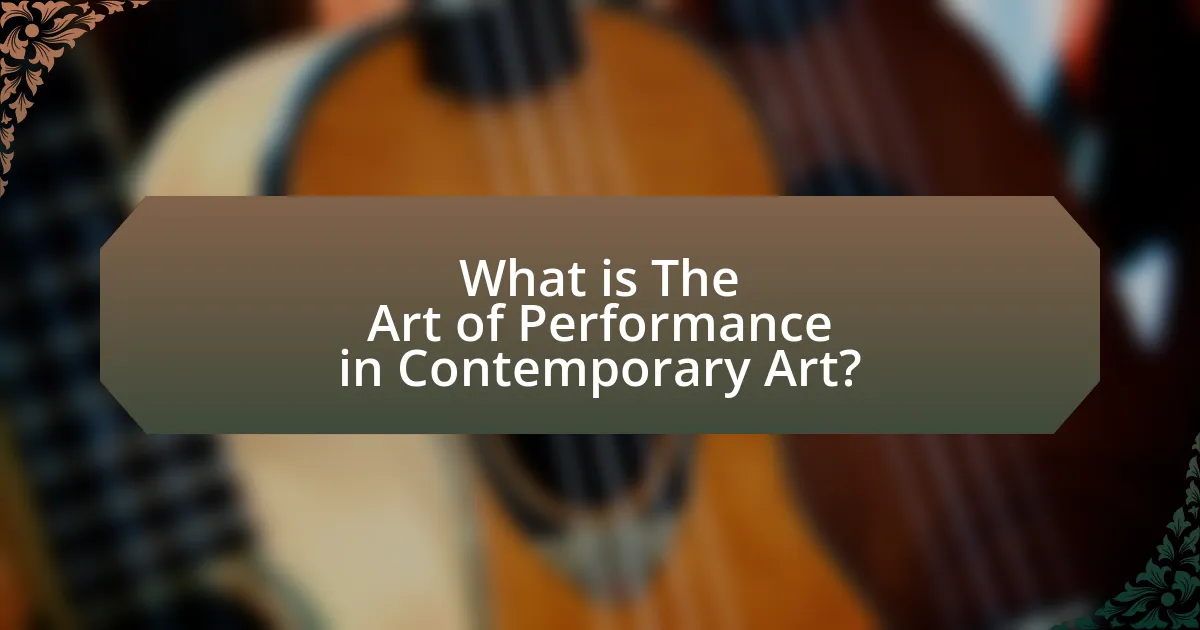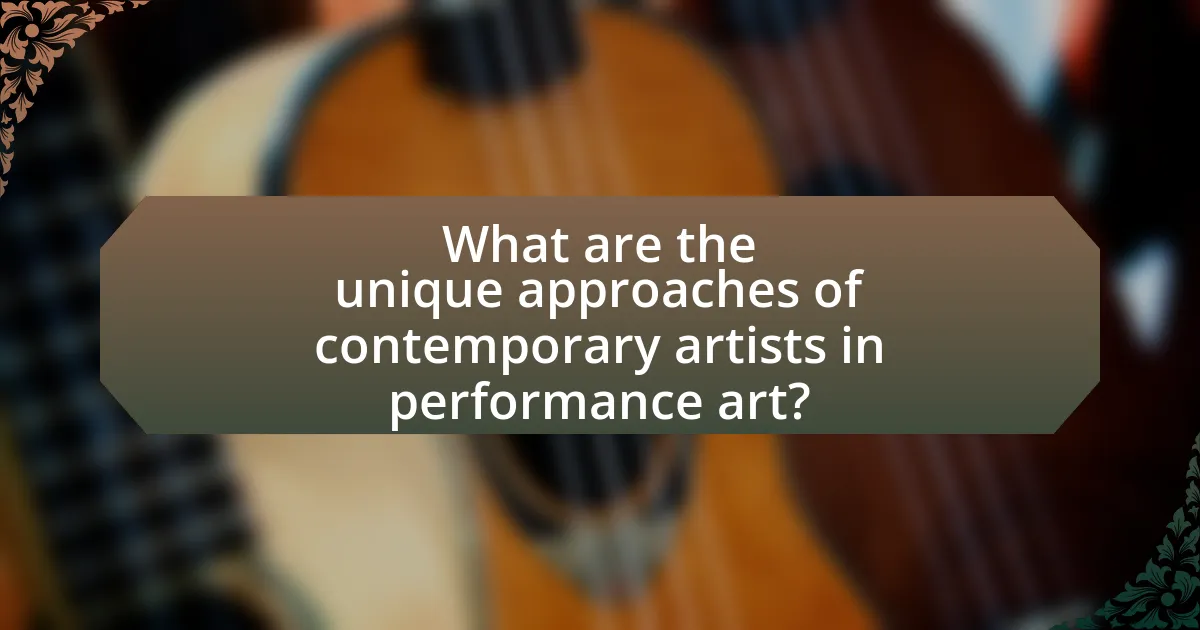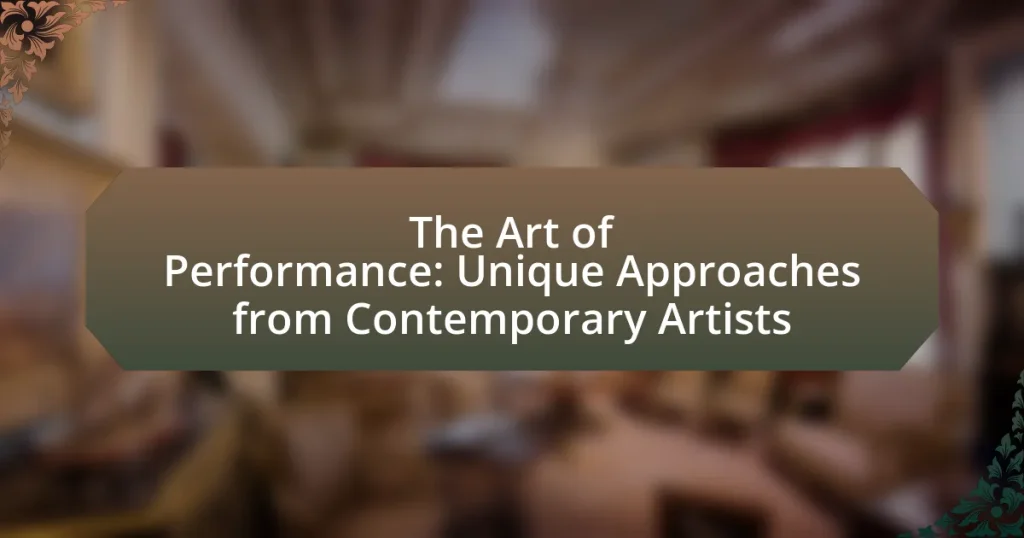The Art of Performance in Contemporary Art is a dynamic form of artistic expression where the artist’s actions become the artwork, engaging audiences in real-time. This practice has evolved from traditional theater to incorporate multimedia elements and interactive technologies, significantly influenced by historical movements such as Dadaism and Fluxus. Contemporary artists redefine performance by addressing themes of identity, social justice, and environmental issues, often inviting audience participation to create immersive experiences. The integration of digital media and technology further enhances these performances, expanding their reach and impact in today’s art world.

What is The Art of Performance in Contemporary Art?
The Art of Performance in Contemporary Art refers to a dynamic form of artistic expression where the artist’s actions become the artwork itself, often engaging the audience in real-time. This practice emerged prominently in the 20th century, with artists like Marina Abramović and Yoko Ono using their bodies and actions to explore themes of identity, politics, and social issues. Performance art challenges traditional boundaries of art by emphasizing the ephemeral nature of the experience, as seen in works like Abramović’s “The Artist is Present,” which involved direct interaction with viewers, highlighting the relational aspect of art.
How has The Art of Performance evolved over time?
The Art of Performance has evolved significantly from its origins in traditional theater and ritualistic practices to contemporary forms that emphasize interactivity and multimedia elements. Initially, performance art was closely tied to established theatrical conventions, focusing on scripted narratives and character portrayals. Over time, artists like Marina Abramović and Yoko Ono challenged these norms by incorporating personal experiences, audience participation, and social commentary into their work. This shift reflects a broader trend towards breaking boundaries between artist and audience, as seen in the rise of immersive performances and site-specific installations. The evolution is also marked by the integration of technology, where digital media and virtual reality have expanded the possibilities of performance, allowing for new forms of expression and engagement.
What historical movements influenced contemporary performance art?
Contemporary performance art is significantly influenced by historical movements such as Dadaism, Futurism, and the Fluxus movement. Dadaism, emerging in the early 20th century, challenged traditional artistic norms and emphasized spontaneity and absurdity, which laid the groundwork for performance as a medium of expression. Futurism, with its focus on dynamism and the celebration of modern technology, also contributed to the energetic and often confrontational nature of contemporary performance art. Additionally, the Fluxus movement of the 1960s promoted the idea of art as an experience rather than a product, encouraging artists to engage audiences through interactive and often ephemeral performances. These movements collectively shaped the evolution of performance art, emphasizing experimentation, audience participation, and the breaking of conventional boundaries.
How do contemporary artists redefine traditional performance practices?
Contemporary artists redefine traditional performance practices by incorporating multimedia elements, interactive technologies, and social commentary into their work. This evolution allows for a more immersive experience, engaging audiences in ways that traditional performances often do not. For instance, artists like Marina Abramović utilize audience participation to challenge the boundaries between performer and spectator, creating a dialogue that transforms the nature of the performance itself. Additionally, the integration of digital platforms enables performances to reach wider audiences, as seen in works that blend live action with virtual reality or streaming. These innovations reflect a shift towards inclusivity and accessibility, fundamentally altering the landscape of performance art.
Why is The Art of Performance significant in today’s art world?
The Art of Performance is significant in today’s art world because it challenges traditional boundaries of artistic expression and engages audiences in interactive experiences. This form of art emphasizes the ephemeral nature of performance, allowing artists to convey complex themes such as identity, politics, and social issues in real-time. For instance, artists like Marina Abramović have utilized performance to explore the limits of endurance and human connection, as seen in her work “The Artist is Present,” which attracted over 750,000 visitors at the Museum of Modern Art in 2010. This engagement not only fosters a deeper emotional connection between the artist and the audience but also reflects contemporary societal dynamics, making performance art a vital component of modern artistic discourse.
What cultural and social issues does performance art address?
Performance art addresses various cultural and social issues, including identity, gender, race, and political activism. Artists utilize performance to challenge societal norms and provoke discussions around these topics. For instance, works by artists like Marina Abramović and Yoko Ono have explored themes of vulnerability and the human experience, while others, such as Adrian Piper, have tackled issues of race and identity politics. These performances often serve as a mirror to society, reflecting and critiquing prevailing attitudes and injustices, thereby fostering awareness and dialogue.
How does performance art engage audiences differently than other art forms?
Performance art engages audiences differently than other art forms by creating an immersive, interactive experience that often involves direct participation or emotional connection. Unlike traditional visual arts, which can be passively observed, performance art typically unfolds in real-time, allowing audiences to witness the spontaneity and unpredictability of the moment. This immediacy fosters a unique relationship between the performer and the audience, as seen in works by artists like Marina Abramović, whose piece “The Artist is Present” invited viewers to sit silently across from her, creating a profound emotional exchange. Such engagement can provoke thought, challenge perceptions, and elicit visceral reactions, making the audience an integral part of the artistic experience.

What are the unique approaches of contemporary artists in performance art?
Contemporary artists in performance art employ unique approaches that often emphasize interactivity, social engagement, and the blurring of boundaries between artist and audience. For instance, artists like Marina Abramović utilize endurance and vulnerability to create immersive experiences that challenge viewers’ perceptions of time and presence. Similarly, artists such as Tania Bruguera focus on political activism, using performance as a medium to address social issues and provoke dialogue within communities. These approaches reflect a shift towards participatory art, where the audience becomes an integral part of the performance, thus redefining the traditional roles within the art experience.
How do contemporary artists incorporate technology into their performances?
Contemporary artists incorporate technology into their performances by utilizing digital media, interactive installations, and live-streaming to enhance audience engagement and create immersive experiences. For instance, artists like Marina Abramović have employed virtual reality to allow viewers to experience her work in new dimensions, while companies such as Cirque du Soleil integrate projection mapping and robotics to elevate their theatrical productions. These technological elements not only expand the creative possibilities but also facilitate real-time interaction, as seen in performances that use audience smartphones to influence the show. This integration of technology reflects a broader trend in the arts where innovation drives new forms of expression and connection with audiences.
What role does digital media play in enhancing performance art?
Digital media significantly enhances performance art by expanding its reach and interactivity. It allows artists to incorporate multimedia elements such as video, sound, and interactive technology, creating immersive experiences that engage audiences on multiple sensory levels. For instance, the integration of live streaming enables performances to be viewed globally, breaking geographical barriers and increasing accessibility. Additionally, digital platforms facilitate audience participation through social media, enabling real-time feedback and interaction, which can influence the performance itself. Research by the Pew Research Center indicates that 72% of adults use social media, highlighting its potential as a tool for engagement in performance art. Thus, digital media not only enriches the artistic expression but also transforms the relationship between the artist and the audience.
How do artists use virtual reality and augmented reality in their work?
Artists use virtual reality (VR) and augmented reality (AR) to create immersive experiences that engage audiences in innovative ways. Through VR, artists can construct entirely virtual environments that allow viewers to explore and interact with their work, as seen in projects like “The Night Cafe” by Mac Cauley, which recreates Vincent van Gogh’s famous painting in a 3D space. In contrast, AR enables artists to overlay digital elements onto the real world, enhancing physical artworks with interactive features, such as in the case of “Augmented Reality Art” by artists like KAWS, where viewers can use their smartphones to see additional layers of content. These technologies expand the boundaries of traditional art forms, allowing for new narratives and participatory experiences that challenge conventional viewing practices.
What themes are commonly explored by contemporary performance artists?
Contemporary performance artists commonly explore themes such as identity, social justice, and the body. These themes reflect the artists’ engagement with personal and collective experiences, often addressing issues like race, gender, and sexuality. For instance, artists like Marina Abramović and Yoko Ono have utilized their bodies to challenge societal norms and provoke discussions about vulnerability and endurance. Additionally, the theme of social justice is prevalent, as seen in works that confront systemic inequalities and advocate for marginalized communities. This focus on identity and social issues is supported by the increasing intersection of art and activism in contemporary performance, highlighting the medium’s role in fostering dialogue and change.
How do artists address identity and personal narratives in their performances?
Artists address identity and personal narratives in their performances by integrating autobiographical elements and cultural references that resonate with their experiences. For instance, performance artists like Marina Abramović utilize their own life stories and emotional experiences to explore themes of vulnerability and endurance, effectively engaging the audience in a dialogue about identity. Additionally, artists such as Yoko Ono incorporate social and political contexts into their work, reflecting on issues of gender and race, which further personalizes their narratives. This approach not only highlights individual experiences but also connects broader societal themes, making the performances relatable and impactful.
What environmental or political themes are prevalent in contemporary performance art?
Contemporary performance art frequently addresses environmental and political themes, with a focus on climate change, social justice, and activism. Artists utilize their work to critique governmental policies, raise awareness about ecological degradation, and advocate for marginalized communities. For instance, the performance piece “The Ocean is a Desert” by artist Marina Abramović highlights the impact of pollution on marine life, while the “Climate Strikes” organized by various artists emphasize the urgency of climate action. These works not only engage audiences but also serve as a platform for dialogue and change, reflecting the growing intersection of art and activism in today’s socio-political landscape.

How do audiences interact with The Art of Performance?
Audiences interact with The Art of Performance through active engagement, participation, and emotional response. This interaction often occurs in real-time during live performances, where audience members may react vocally or physically, influencing the atmosphere and energy of the event. For instance, studies have shown that audience feedback, such as applause or laughter, can significantly impact performers’ delivery and the overall experience, creating a dynamic exchange between the artist and the audience. Additionally, contemporary artists often incorporate elements that invite audience participation, such as interactive installations or immersive experiences, further enhancing the connection and involvement of the audience in the performance.
What are the different ways audiences can experience performance art?
Audiences can experience performance art through live events, digital platforms, and interactive installations. Live events allow audiences to engage directly with the performers in real-time, creating a shared experience that can evoke immediate emotional responses. Digital platforms, such as streaming services and social media, enable audiences to access performance art remotely, broadening the reach and allowing for diverse interpretations. Interactive installations invite audience participation, blurring the lines between performer and viewer, and fostering a more immersive experience. Each method enhances the audience’s connection to the art, demonstrating the versatility and evolving nature of performance art.
How does the setting influence audience engagement in performance art?
The setting significantly influences audience engagement in performance art by shaping the atmosphere and context in which the performance occurs. A well-designed setting can enhance emotional responses, facilitate interaction, and create a sense of immersion for the audience. For instance, performances held in unconventional spaces, such as abandoned buildings or outdoor environments, often evoke stronger reactions due to their unique characteristics and the unexpected nature of the experience. Research by the University of California, Berkeley, indicates that immersive environments can increase audience participation and emotional investment, demonstrating that the physical context directly impacts engagement levels.
What role does audience participation play in contemporary performances?
Audience participation plays a crucial role in contemporary performances by enhancing engagement and creating a shared experience between performers and spectators. This interactive dynamic allows audiences to influence the narrative and emotional tone of the performance, fostering a sense of community and immediacy. Research indicates that performances incorporating audience interaction can lead to increased emotional investment and satisfaction, as seen in works by artists like Marina Abramović, who invites viewers to participate directly, thereby blurring the lines between artist and audience. Such participatory elements not only enrich the artistic experience but also challenge traditional performance boundaries, making the audience an integral part of the artistic process.
How can one appreciate and critique performance art effectively?
To appreciate and critique performance art effectively, one should engage with the work through observation, emotional response, and contextual understanding. Observing the details of the performance, such as the artist’s movements, use of space, and audience interaction, allows for a deeper appreciation of the artistic choices made. Emotional responses are crucial, as they reflect the impact of the performance on the viewer, which can be analyzed in terms of how well the artist conveyed their intended message. Contextual understanding involves researching the artist’s background, the themes being explored, and the cultural or historical significance of the work, which enriches the critique. For instance, understanding Marina Abramović’s “The Artist is Present” requires knowledge of her exploration of presence and endurance in art, which enhances both appreciation and critique.
What criteria should be considered when evaluating a performance piece?
When evaluating a performance piece, key criteria include artistic intent, audience engagement, technical execution, and thematic depth. Artistic intent refers to the creator’s purpose and message, which can be assessed through the clarity and originality of the concept. Audience engagement measures how effectively the performance captivates and interacts with viewers, influencing their emotional and intellectual responses. Technical execution involves the skill and professionalism displayed in the performance, including aspects such as choreography, staging, and use of technology. Thematic depth examines the complexity and relevance of the ideas presented, considering how well they resonate with contemporary issues or provoke thought. These criteria collectively provide a comprehensive framework for assessing the quality and impact of a performance piece.
How can viewers develop a deeper understanding of performance art?
Viewers can develop a deeper understanding of performance art by actively engaging with the context, themes, and intentions behind the work. This engagement can be achieved through research on the artist’s background, the historical and cultural significance of the performance, and the specific techniques employed. For instance, understanding the socio-political commentary in Marina Abramović’s works enhances appreciation of her performances, which often challenge the boundaries of endurance and vulnerability. Additionally, attending artist talks, workshops, and discussions can provide insights directly from the creators, further enriching the viewer’s perspective.
What practical tips can enhance the experience of engaging with performance art?
To enhance the experience of engaging with performance art, actively participate by immersing yourself in the environment and being open to the emotions conveyed. Engaging with performance art requires viewers to be present and responsive, as the art form often relies on audience interaction and emotional resonance. Research indicates that active participation can deepen understanding and appreciation, as seen in studies highlighting the impact of audience involvement on the overall experience of live performances.
